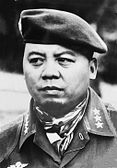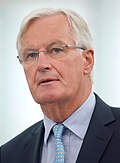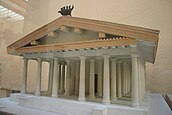Wikipedia:Main Page history/2024 September 13
From today's featured article
An attempted coup took place on September 13, 1964, in South Vietnam against the ruling military junta, led by Nguyễn Khánh (pictured). In the preceding month, Khánh had tried to improve his leadership by declaring a state of emergency, provoking protests and riots. He made concessions to the protesters and removed military officials linked to former President Ngo Dinh Diem, including Lâm Văn Phát and Dương Văn Đức. They responded with a coup, broadcasting their promise to revive Diem's policies. Khánh evaded capture and rallied allies while the U.S. continued their support for his rule. Khánh forced Phát and Đức to capitulate the next morning and various coup leaders appeared at a media conference where they denied that a coup had taken place. To maintain power, Khánh tried to court support from Buddhist activists, who supported negotiations to end the Vietnam War. As the Americans were strongly opposed to such policies, relations with Khánh became strained. (Full article...)
Did you know ...

- ... that operatic tenor Walter Kirchhoff (pictured) was also an officer in the cavalry division of the Imperial German Army?
- ... that the Permanent Mission of Indonesia to the United Nations is housed in a former public bath?
- ... that rugby sevens player Malacchi Esdale said that the conditioning he went through to play in the Olympics was "borderline crazy"?
- ... that Fantasy, performed at the Luxor Las Vegas hotel, is the longest-duration topless production in Las Vegas at a single venue?
- ... that two kidnapped activists were released after claiming at a press conference that they were abducted by government forces?
- ... that Mary Jane Patterson, whose mother was an African-American slave, gained a BA degree in 1862 having taken a "gentleman's course"?
- ... that the angel's wings in the live-action television-drama adaptation of One Room Angel took about a month to construct?
- ... that Dorothy Stanley was once said to be one of the last speakers of the Miwok languages?
- ... that some fan wikis document fan fiction?
In the news
- Typhoon Yagi leaves more than 370 people dead across six Asian countries.
- Michel Barnier (pictured) is appointed prime minister of France by President Emmanuel Macron, leading to nationwide anti-government protests.
- An attempted jailbreak at Makala Central Prison in Kinshasa, Democratic Republic of the Congo, leaves 129 people dead.
- A Mil Mi-8 helicopter crashes in Kamchatka, Russia, killing all 22 people on board.
On this day
- 509 BC – According to Roman tradition, the Temple of Jupiter Optimus Maximus (depicted), the most important temple in ancient Rome, was dedicated.
- 1567 – The siege of Inabayama Castle, the final battle in Oda Nobunaga's campaign to conquer Mino Province, began; it culminated in a decisive victory for Nobunaga.
- 1848 – An explosion drove an iron rod through the head of railroad foreman Phineas Gage; his survival and recovery influenced 19th-century discussion of psychology and neuroscience.
- 1919 – The Boston police strike ended after four days of rule by the state militia, the deaths of nine people, and accusations that striking officers were "agents of Lenin".
- 2005 – A software bug caused a simulated pandemic in the online video game World of Warcraft, serving as a model for epidemiologists to understand how human interaction influences disease outbreaks.
- Kavad I (d. 531)
- Laura Secord (b. 1775)
- Arnold Schoenberg (b. 1874)
- Louis Laybourne Smith (d. 1965)
From today's featured list
In 1961, Billboard magazine launched a chart ranking the top-performing songs in the United States which were considered to be "easy listening". The chart has undergone various name changes and since 1996 has been published under the title Adult Contemporary. Initially, the listing was compiled simply by extracting from the magazine's pop music chart, the Hot 100, those songs which were deemed by the magazine's staff to fit under the Easy Listening banner and ranking them according to their placings on the Hot 100. In 1961, seven different songs topped the Easy Listening chart in 24 issues of the magazine. The number one song on the first Easy Listening chart was "The Boll Weevil Song" by Brook Benton (pictured), which was at number 2 on the Hot 100 that week. The longest-running Easy Listening number one of 1961 was "Big Bad John" by Jimmy Dean, which spent the final ten weeks of the year in the top spot. It was one of three songs to top the Hot 100 as well as the Easy Listening chart during the year, along with "Wooden Heart" by Joe Dowell and "Michael" by the Highwaymen. (Full list...)
Today's featured picture

|
Grand Prismatic Spring in Yellowstone National Park is the largest hot spring in the United States, and the third largest in the world. It is located in the Midway Geyser Basin. Grand Prismatic Spring was noted by geologists working in the Hayden Geological Survey of 1871, and named by them for its striking coloration. Its colors match most of those seen in the rainbow dispersion of white light by an optical prism: red, orange, yellow, green, and blue. The bright, vivid colors in the spring are the result of microbial mats around the edges of the mineral-rich water. The mats produce colors ranging from green to red; the amount of color in the microbial mats depends on the ratio of chlorophyll to carotenoids and on the temperature gradient in the runoff. In the summer, the mats tend to be orange and red, whereas in the winter the mats are usually dark green. The deep blue color of the water in the center of the pool results from the intrinsic blue color of water. The effect is strongest in the center of the spring, because of its sterility and depth. This aerial photo shows Grand Prismatic Spring from the south in August 2022. Photograph credit: Carsten Steger
Recently featured:
|
Other areas of Wikipedia
- Community portal – The central hub for editors, with resources, links, tasks, and announcements.
- Village pump – Forum for discussions about Wikipedia itself, including policies and technical issues.
- Site news – Sources of news about Wikipedia and the broader Wikimedia movement.
- Teahouse – Ask basic questions about using or editing Wikipedia.
- Help desk – Ask questions about using or editing Wikipedia.
- Reference desk – Ask research questions about encyclopedic topics.
- Content portals – A unique way to navigate the encyclopedia.
Wikipedia's sister projects
Wikipedia is written by volunteer editors and hosted by the Wikimedia Foundation, a non-profit organization that also hosts a range of other volunteer projects:
-
Commons
Free media repository -
MediaWiki
Wiki software development -
Meta-Wiki
Wikimedia project coordination -
Wikibooks
Free textbooks and manuals -
Wikidata
Free knowledge base -
Wikinews
Free-content news -
Wikiquote
Collection of quotations -
Wikisource
Free-content library -
Wikispecies
Directory of species -
Wikiversity
Free learning tools -
Wikivoyage
Free travel guide -
Wiktionary
Dictionary and thesaurus
Wikipedia languages
This Wikipedia is written in English. Many other Wikipedias are available; some of the largest are listed below.
-
1,000,000+ articles
-
250,000+ articles
-
50,000+ articles




